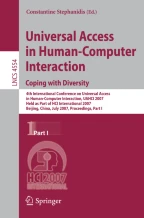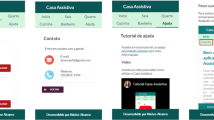On Some Aspects of Improving Mobile Applications for the Elderly

Improving the quality of life of elderly people is an emerging issue within our information society for both research and development. This paper addresses some issues on the development of applications for mobile devices, which have been designed to enhance the quality of life of the growing number of elderly people, and how they can be made more acceptable to the target population. We summarize some relevant issues in order to devise a research methodology to cover more than just the technological and physical aspects of user interfacing but also psychological and sociological aspects. One aspect of achieving this aim is to confront designers and developers with those problems that the elderly face daily and which are not easily understood – especially by younger designers and developers. Finally, we present some issues on how to simulate certain physical constraints of elderly by using the AgeSim, which is a simulation suit. However, not only physical but also cognitive impairment cause problems amongst elderly and result in fear, anxiety and consequently in rejection. The main goal of this paper is to raise awareness amongst developers on which problems are to be taken into considerations during design and development of mobile applications for the elderly.
Chapter PDF
Similar content being viewed by others

Mobile AgeCI: Potential Challenges in the Development and Evaluation of Mobile Applications for Elderly People
Chapter © 2015

Acceptance and Use of Mobile Devices and Apps by Elderly People
Chapter © 2018

Design and evaluation of a mobile smart home interactive system with elderly users in Brazil
Article 09 June 2020
Keywords
- Usability
- Mobile Interfaces
- User-Centered Design
- Age Simulator
References
- Young, P.C.: Digital divide. IEEE Control Systems Magazine 26(6), 16–17 (2006) ArticleGoogle Scholar
- Cooper, J.: The digital divide: the special case of gender. Journal Of Computer Assisted Learning 22(5), 320–334 (2006) ArticleGoogle Scholar
- Kieras, D., Polson, P.G.: An Approach to the Formal Analysis of User Complexity. International Journal of Man-Machine Studies 22(4), 365–394 (1985) ArticleGoogle Scholar
- Sweller, J.: Cognitive load during problem solving: Effects on learning. Cognitive Science 12(2), 257–285 (1988) ArticleGoogle Scholar
- Kieras, D., Polson, P.G.: An approach to the formal analysis of user complexity. International Journal of Human-Computer Studies 51(2), 405–434 (1999) ArticleGoogle Scholar
- Ziefle, M., Bay, S.: How older adults meet complexity: aging effects on the usability of different mobile phones. Behaviour & Information Technology 24(5), 375–389 (2005) ArticleGoogle Scholar
- Midford, R., Kirsner, K.: Implicit and explicit learning in aged and young adults. Aging Neuropsychology And Cognition 12(4), 359–387 (2005) ArticleGoogle Scholar
- Hertzog, C., Bleckley, M.K.: Age differences in the structure of intelligence - Influences of information processing speed. Intelligence 29(3), 191–217 (2001) ArticleGoogle Scholar
- Mynatt, E.D., Melenhorst, A.S., Fisk, A.D., Rogers, W.A.: Aware technologies for aging in place: Understanding user needs and attitudes. Ieee Pervasive Computing 3(2), 36–41 (2004) ArticleGoogle Scholar
- Melenhorst, A.S., Rogers, W.A., Bouwhuis, D.G.: Older adults’ motivated choice for technological innovation: Evidence for benefit-driven selectivity. Psychology and Aging 21(1), 190–195 (2006) ArticleGoogle Scholar
- Ellis, R.D., Allaire, J.C.: Modeling computer interest in older adults: The role of age, education, computer knowledge, and computer anxiety. Human Factors 41(3), 345–355 (1999) ArticleGoogle Scholar
- Ziefle, M.: The influence of user expertise and phone complexity on performance, ease of use and learnability of different mobile phones. Behaviour & Information Technology 21(5), 303–311 (2002) ArticleGoogle Scholar
- Lines, L., Hone, K.S.: Eliciting user requirements with older adults: lessons from the design of an interactive domestic alarm system. Universal Access in the Information Society 3(2), 141–148 (2004) ArticleGoogle Scholar
- Irizarry, C., Downing, A.: Computers enhancing the lives of older people. Australian Journal On Ageing 16(4), 161–165 (1997) ArticleGoogle Scholar
- Ansell, B.M.: Psyche And Rheuma. Journal Of International Medical Research 4, 50–53 (1976) Google Scholar
- Rogers, W.A., Fisk, A.D., Mead, S.E., Walker, N., Cabrera, E.F.: Training older adults to use automatic teller machines. Human Factors 38(3), 425–433 (1996) ArticleGoogle Scholar
- Smith, M.W., Sharit, J., Czaja, S.J.: Aging, motor control, and the performance of computer mouse tasks. Human Factors 41(3), 389–396 (1999) ArticleGoogle Scholar
- Vingerling, J.R., Dielemans, I., Bots, M.L., Hofman, A., Grobbee, D.E., Dejong, P.: Age-Related Macular Degeneration Is Associated With Atherosclerosis - The Rotterdam Study. American Journal Of. Epidemiology 142(4), 404–409 (1995) Google Scholar
- Augood, C.A., Vingerling, J.R., de Jong, P., Chakravarthy, U., Seland, J., Soubrane, G., Tomazzoli, L., Topouzis, F., Bentham, G., Rahu, M., Vioque, J., Young, I.S., Fletcher, A.E.: Prevalence of age-related maculopathy in older Europeans - The European Eye Study (EUREYE). Archives Of Ophthalmology 124(4), 529–535 (2006) ArticleGoogle Scholar
- Gates, G.A., Mills, J.H.: Presbycusis. Lancet 366(9491), 1111–1120 (2005) ArticleGoogle Scholar
- Jonsson, R., Rosenhall, U.: Hearing in advanced age. A study of presbyacusis in 85-, 88- and 90-year-old people. Audiology 37(4), 207–218 (1998) Google Scholar
- Jonsson, I.M., Nass, C., Lee, K.M.: Mixing personal computer and handheld interfaces and devices: effects on perceptions and attitudes. International Journal Of Human-Computer Studies 61(1), 71–83 (2004) ArticleGoogle Scholar
- Gordon-Salant, S.: Hearing loss and aging: New research findings and clinical implications. Journal Of Rehabilitation Research And Development 42(4), 9–23 (2005) ArticleGoogle Scholar
- Norman, S., Kemper, S., Kynette, D.: Adults Reading-Comprehension - Effects of Syntactic Complexity and Working Memory. Journals of Gerontology 47(4), P258–P265 (1992) Google Scholar
- Holzinger, A.: User-Centered Interface Design for disabled and elderly people: First experiences with designing a patient communication system (PACOSY). In: Miesenberger, K., Klaus, J., Zagler, W. (eds.) ICCHP 2002. LNCS, vol. 2398, pp. 34–41. Springer, Heidelberg (2002) Google Scholar
- Holzinger, A.: Finger Instead of Mouse: Touch Screens as a means of enhancing Universal Access. In: Carbonell, N., Stephanidis, C. (eds.) Universal Access. Theoretical Perspectives, Practice, and Experience. LNCS, vol. 2615, pp. 387–397. Springer, Heidelberg (2003) Google Scholar
- Thornbury, J.M., Mistretta, C.M.: Tactile Sensitivity as a Function of Age. Journals of Gerontology 36(1), 34–39 (1981) Google Scholar
- Norman, D.A., Draper, S.: User Centered System Design. Erlbaum, Hillsdale NY (1986) Google Scholar
- Holzinger, A.: Experiences with User Centered Development (UCD) for the Front End of the Virtual Medical Campus Graz. In: Jacko, J.A., Stephanidis, C. (eds.) Human-Computer Interaction, Theory and Practice, pp. 123–127. Lawrence Erlbaum, Mahwah (2003) Google Scholar
- Holzinger, A.: Application of Rapid Prototyping to the User Interface Development for a Virtual Medical Campus. IEEE Software 21(1), 92–99 (2004) ArticleGoogle Scholar
- Stephanidis, C., Savidis, A.: Universal Access in the Information Society: Methods, Tools and Interaction Technologies. Universal Access in the Information Society 1(1), 40–55 (2001) Google Scholar
Author information
Authors and Affiliations
- Institute for Medical Informatics, Statistics & Documentation (IMI), Research Unit HCI4MED, Medical University of Graz, A-8036 Graz, Austria Andreas Holzinger & Gig Searle
- School of Information Management, Digital Media Technologies Laboratory, University of Applied Sciences FH JOANNEUM, A-8020 Graz, Austria Alexander Nischelwitzer
- Andreas Holzinger


